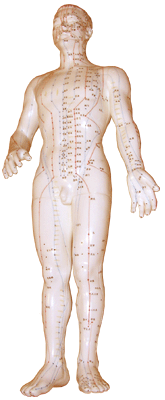 In Chinese medicine the channels that conduct energy throughout the body are called “meridians.” These conduits form a network. If the network is disrupted, if blockages occur, the body will not function properly – Chi, Ching, and Shen do not flow as required, the organs will not perform their function, and imbalance arises. When the meridians are clear and open, energy flows freely and all is well once more.
In Chinese medicine the channels that conduct energy throughout the body are called “meridians.” These conduits form a network. If the network is disrupted, if blockages occur, the body will not function properly – Chi, Ching, and Shen do not flow as required, the organs will not perform their function, and imbalance arises. When the meridians are clear and open, energy flows freely and all is well once more.
When we looked at the highways within our subtle body from the yogic perspective, we discovered the ancient yogis sensed thousands upon thousands of individual passageways, which they called the nadis. Some text suggested there were seventy-two thousand nadis while other texts claimed there were three hundred thousand. The use of large numbers is not meant to give an exact tally of how many lines of energy there actually are in the body. Large numbers simply signify that there are too many to count. The learning to be taken here is that our bodies are full of conduits for the subtle energies that flow within us. [1]
As in India, the Chinese mystics realized that not all channels are equally important. The Indian yogis described eleven nadis by name and further claimed that only three were really important for spiritual practice. In China, with a greater concern over physical well-being and longevity, seventy-one meridians were named and of these, fourteen were most important. Each of the ten major organs has its associated meridian, and the meridian may be yin or yang, depending upon the zang or fu nature of the organ it pertains to. Additionally, the pericardium and the San Jiao also have their associated meridians, which, along with the others, make up twelve major meridians, known as a group as Jing Mai. We can consider these twelve to be major channels.
Each of the major channels has one or more collateral channels, side roads leading to destinations other than the pertaining organ. Along the meridians are found special points that can be stimulated, through acupuncture, to mobilize energy or remove blockages. On the major meridians, there are three hundred and sixty-one regular points, although during an examination a Chinese doctor may discover even more. In more recent times, a branch of acupuncture focusing just on the ear has discovered fifty-four additional points on each ear.
In all there over two thousand acupuncture points used to help maintain or rebuild health. That is far too many for us to investigate in this journey. The interested reader can take up the trail by studying one of the many textbooks used in Traditional Chinese Medicine [2] training such as the newly compiled Chinese Acupuncture and Moxibustion, published by the Shanghai University. Even more highly recommended, and easier to follow, is Ted Kaptchuk’s book The Web That Has No Weaver.
We will limit our investigation to the fourteen most-discussed meridians. There are six meridians that begin or end in the feet. Relative to their position in the body these meridians can be considered yin meridians, compared to another six that begin or end in the hands, which can be considered yang meridians. Being yin meridians, these lower ones are more strongly affected during a Yin Yoga practice than the higher yang meridians. We will begin our investigation with these six lower lines. Note that we will describe each meridian as a single line but usually there are two meridians; one for each side of the body.
- — In Thailand a similar model of energy movement evolved through a cross-fertilization of Indian and Chinese influences. The lines of energy manipulated in Thai Yoga massage are called sens. Thai massage can be considered a form of acupressure which stimulates the flow of energy along the sen lines.
- — It should be noted that the Traditional Chinese Medicine is not the original Chinese Medicine! Mark Seem, a former president of the Council of Colleges of Acupuncture and Oriental Medicine, writes in his book Acupuncture Imaging, “The label [TCM] is inappropriate for two reasons. First it obscures the fact that there has never been one traditional medicine in China. Second this very modern reformulation of Chinese medicine is a recent invention.” In the forward to this book, Bob Flows writes, “[TCM] refers to a specific style of Chinese medicine developed and taught in the People’s Republic of China over the last forty years TCM is a style of Chinese medicine rather than its totality” Flows notes that TCM focuses mostly on the fourteen key meridians but ignores “the other fifty-seven of the seventy-one channels and collaterals described in classical Chinese acupuncture.”
(Next: The Lower Body Meridians )
